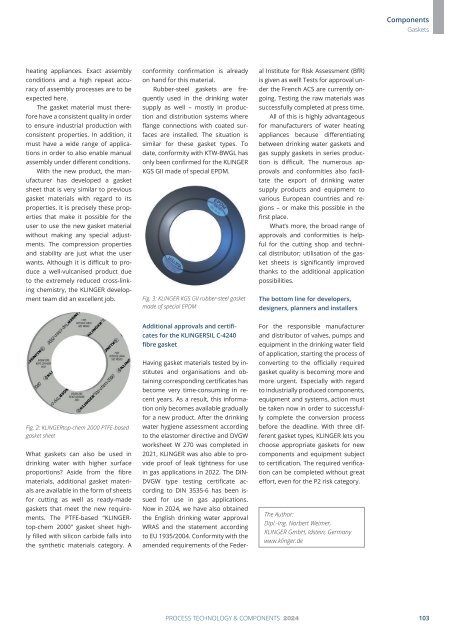PuK - Process Technology & Components 2024
A technical trade magazine with a history of more than 60 years.
A technical trade magazine with a history of more than 60 years.
Create successful ePaper yourself
Turn your PDF publications into a flip-book with our unique Google optimized e-Paper software.
<strong>Components</strong><br />
Gaskets<br />
heating appliances. Exact assembly<br />
conditions and a high repeat accuracy<br />
of assembly processes are to be<br />
expected here.<br />
The gasket material must therefore<br />
have a consistent quality in order<br />
to ensure industrial production with<br />
consistent properties. In addition, it<br />
must have a wide range of applications<br />
in order to also enable manual<br />
assembly under different conditions.<br />
With the new product, the manufacturer<br />
has developed a gasket<br />
sheet that is very similar to previous<br />
gasket materials with regard to its<br />
properties. It is precisely these properties<br />
that make it possible for the<br />
user to use the new gasket material<br />
without making any special adjustments.<br />
The compression properties<br />
and stability are just what the user<br />
wants. Although it is difficult to produce<br />
a well-vulcanised product due<br />
to the extremely reduced cross-linking<br />
chemistry, the KLINGER development<br />
team did an excellent job.<br />
conformity confirmation is already<br />
on hand for this material.<br />
Rubber-steel gaskets are frequently<br />
used in the drinking water<br />
supply as well – mostly in production<br />
and distribution systems where<br />
flange connections with coated surfaces<br />
are installed. The situation is<br />
similar for these gasket types. To<br />
date, conformity with KTW-BWGL has<br />
only been confirmed for the KLINGER<br />
KGS GII made of special EPDM.<br />
Fig. 3: KLINGER KGS GII rubber-steel gasket<br />
made of special EPDM<br />
al Institute for Risk Assessment (BfR)<br />
is given as well! Tests for approval under<br />
the French ACS are currently ongoing.<br />
Testing the raw materials was<br />
successfully completed at press time.<br />
All of this is highly advantageous<br />
for manufacturers of water heating<br />
appliances because differentiating<br />
between drinking water gaskets and<br />
gas supply gaskets in series production<br />
is difficult. The numerous approvals<br />
and conformities also facilitate<br />
the export of drinking water<br />
supply products and equipment to<br />
various European countries and regions<br />
– or make this possible in the<br />
first place.<br />
What’s more, the broad range of<br />
approvals and conformities is helpful<br />
for the cutting shop and technical<br />
distributor; utilisation of the gasket<br />
sheets is significantly improved<br />
thanks to the additional application<br />
possibilities.<br />
The bottom line for developers,<br />
designers, planners and installers<br />
Fig. 2: KLINGERtop-chem 2000 PTFE-based<br />
gasket sheet<br />
What gaskets can also be used in<br />
drinking water with higher surface<br />
proportions? Aside from the fibre<br />
materials, additional gasket materials<br />
are available in the form of sheets<br />
for cutting as well as ready-made<br />
gaskets that meet the new requirements.<br />
The PTFE-based “KLINGERtop-chem<br />
2000” gasket sheet highly<br />
filled with silicon carbide falls into<br />
the synthetic materials category. A<br />
Additional approvals and certificates<br />
for the KLINGERSIL C-4240<br />
fibre gasket<br />
Having gasket materials tested by institutes<br />
and organisations and obtaining<br />
corresponding certificates has<br />
become very time-consuming in recent<br />
years. As a result, this information<br />
only becomes available gradually<br />
for a new product. After the drinking<br />
water hygiene assessment according<br />
to the elastomer directive and DVGW<br />
worksheet W 270 was completed in<br />
2021, KLINGER was also able to provide<br />
proof of leak tightness for use<br />
in gas applications in 2022. The DIN-<br />
DVGW type testing certificate according<br />
to DIN 3535-6 has been issued<br />
for use in gas applications.<br />
Now in <strong>2024</strong>, we have also obtained<br />
the English drinking water approval<br />
WRAS and the statement according<br />
to EU 1935/2004. Conformity with the<br />
amended requirements of the Feder-<br />
For the responsible manufacturer<br />
and distributor of valves, pumps and<br />
equipment in the drinking water field<br />
of application, starting the process of<br />
converting to the officially required<br />
gasket quality is becoming more and<br />
more urgent. Especially with regard<br />
to industrially produced components,<br />
equipment and systems, action must<br />
be taken now in order to successfully<br />
complete the conversion process<br />
before the deadline. With three different<br />
gasket types, KLINGER lets you<br />
choose appropriate gaskets for new<br />
components and equipment subject<br />
to certification. The required verification<br />
can be completed without great<br />
effort, even for the P2 risk category.<br />
The Author:<br />
Dipl.-Ing. Norbert Weimer,<br />
KLINGER GmbH, Idstein, Germany<br />
www.klinger.de<br />
PROCESS TECHNOLOGY & COMPONENTS <strong>2024</strong><br />
103

















